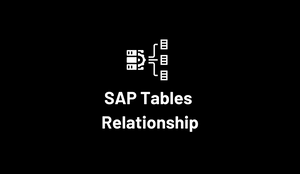SAP Tables are the core objects in SAP for data storage and management. Relations between SAP tables are defined through various types of relationships like one-to-one, one-to-many, many-to-one and many-to-many.
These relationships are established through key fields in the tables, which act as links between tables.
Some common relationships between SAP tables are:
- One-to-One: In this relationship, one record in a table is related to only one record in another table.
- One-to-Many: In this relationship, one record in a table is related to multiple records in another table. For example, a customer can have multiple orders.
- Many-to-One: In this relationship, multiple records in a table are related to only one record in another table. For example, multiple sales orders can be related to a single customer.
- Many-to-Many: In this relationship, multiple records in one table can be related to multiple records in another table. For example, a customer can have multiple orders and an order can belong to multiple customers.
Understanding the relationships between SAP tables is important for efficiently designing, developing, and maintaining SAP data analytics solutions.
1. How to use this document?

2. Important Master Data Tables


